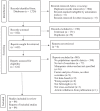Correlates of palpitations during menopause: A scoping review
- PMID: 35833667
- PMCID: PMC9289918
- DOI: 10.1177/17455057221112267
Correlates of palpitations during menopause: A scoping review
Abstract
Objective: Palpitations during peri- and post-menopause are common. It is unclear what variables are related to palpitations in peri- and post-menopausal women. The purpose of this scoping review was to summarize potential correlates of palpitations in women transitioning through menopause.
Methods: The review followed the Preferred Reporting Items for Systematic reviews and Meta-Analyses extension for Scoping Reviews (PRISMA-ScR). Authors included English-language, full-length, peer-reviewed, cross-sectional research articles on palpitations in menopausal women published through December 18, 2021, from PubMed, Cumulative Index to Nursing and Allied Health Literature (CINAHL), and PsycINFO searches. Following de-duplication, screening of titles and abstracts, and review of full-texts, independent reviewers extracted data on variables studied in relationship to palpitations from 84 articles and resolved discrepancies. Authors extracted data on (1) demographic, clinical, biomarker, and symptom/quality of life variables and (2) data analysis method (bivariate, multivariate). Authors classified each variable as a likely, unlikely, or unclear correlate of palpitations.
Results: Articles were diverse in region of origin, sample sizes, and variables assessed in relationship to palpitations. Evidence for any one variable was sparse. Likely correlates of palpitations included race/ethnicity, lower physical activity, worse vasomotor symptoms (VMSs), worse sleep, and worse quality of life. Unlikely correlates included age, employment, education, marital status, socioeconomic status, comorbidities, body mass index, and sexual difficulties. Unclear correlates due to equivocal evidence were menopausal status, smoking, and depression. Unclear correlates due to insufficient evidence (less than three articles) included all of the assessed biomarkers, anxiety, and stress.
Conclusion: Likely correlates were identified including race/ethnicity, physical activity, VMS, sleep, and quality of life. However, additional research is needed to better understand potential correlates of palpitations.
Keywords: cardiology; menopause; perimenopause; postmenopause; review.
Conflict of interest statement
Figures

References
-
- North American Menopause Society. Menopause practice: a clinician’s guide. 6th ed. Mayfield Heights, OH: North American Menopause Society, 2019, 266 pp.
-
- Sievert LL. Variation in sweating patterns: implications for studies of hot flashes through skin conductance. Menopause 2007; 14(4): 742–751. - PubMed
-
- Dennerstein L, Lehert P, Burger HG, et al.. New findings from non-linear longitudinal modeling of menopausal hormone changes. Hum Reprod Update 2007; 13: 551–557. - PubMed
-
- Carpenter JS, Sheng Y, Elomba C, et al.. A systematic review of palpitations prevalence by menopausal status. Curr Obstet Gynecol Rep 2021; 10: 7–13.
Publication types
MeSH terms
Grants and funding
LinkOut - more resources
Full Text Sources
Medical

